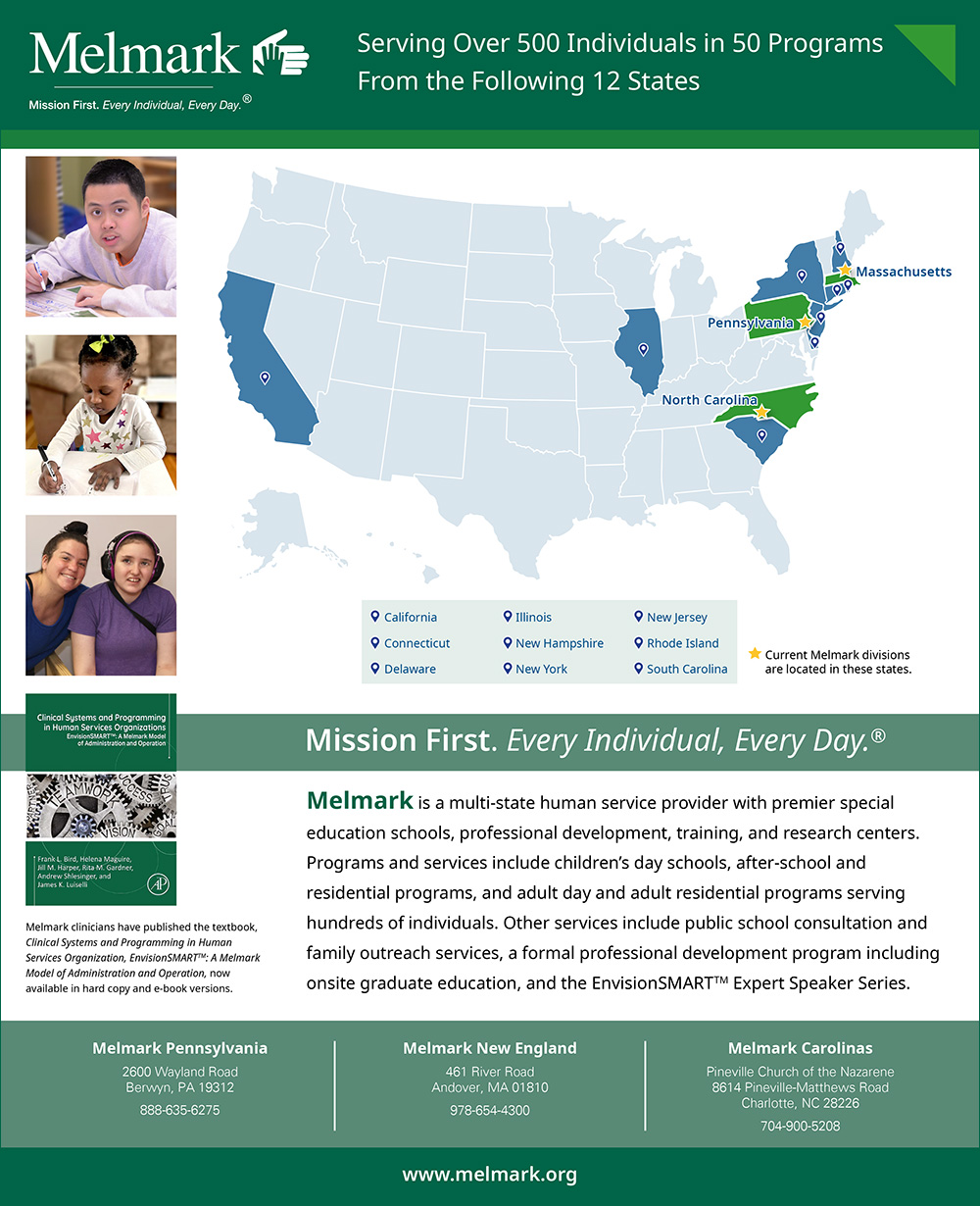Individuals with complex behavioral and medical profiles require an interdisciplinary approach due to multiple specialized areas of need. This approach allows interdisciplinary teams to efficiently address multiple presenting needs simultaneously and comprehensively (Boivin et al., 2021). This collaborative process requires trust, respect, clearly defined and equitable roles, commitment, and accountability. It requires each discipline to have comprehensive knowledge of their specialty, as well as an understanding of other team members’ roles, including training, experience, and scope of practice (Boivin et al., 2015; Brodhead, 2015; LaFrance et al., 2019; Slim & Reuter-Yuill, 2021). In theory, all clients benefit from interdisciplinary collaboration. In some instances, however, such collaborative care is essential. When the needs of the individual require specialized expertise from multiple disciplines, a collaborative team approach is needed. It is important to focus on the values of the team approach, the roles and responsibilities of each member, and the quality of interprofessional collaboration and teamwork (Slim & Reuter-Yuill, 2021).

This article highlights the importance of an interdisciplinary approach to obtaining a medical diagnosis for an individual with a complex behavioral profile related to an underlying medical condition. The individual was a 20-year-old male with diagnoses of autism spectrum disorder and attention deficit and hyperactivity disorder. They were non-verbal and utilized an AAC device to communicate their wants/needs throughout their day. This individual attended a residential and school program (Melmark), where the primary methodology is applied behavior analysis. Due to a challenging behavior profile, the individual was taught using a 2:1 staff-to-student ratio for their school and residential days. The individual received allied services in speech and language pathology, occupational therapy, and physical therapy.
Regarding their behavioral profile, the individual engaged in inappropriate use of materials (i.e., throwing, swiping, crumpling), displayed difficulty remaining seated during academic instruction, demonstrated inappropriate and/or unsafe behaviors when moving from one area to another or when seated near peers, minimizing opportunities to participate in group instruction, and engaged in kicking towards walls, dropping to the floor to engage in head directed self-injury, hitting head to walls, and attempting to access unsafe areas. Historically and currently, this individual engaged in high rates of challenging behaviors (e.g., aggression, self-injury, disrobing, property destruction [e.g., throwing objects], and ritualistic behaviors), which limited access to some environments, social interactions, and academic programming. They also demonstrated resistance in the form of aggression and self-injury when access to preferred activity/items and ritualistic behavior was restricted and/or blocked and demonstrated limited safety awareness during transitions (e.g., kicking dangerous items, knocking over items, climbing on furniture). This individual did not demonstrate awareness or understanding of risks to the individual’s self or others when engaging in these topographies of challenging behavior.
Other aspects of their daily routine and health were examined to better understand the individual. The individual, at times, showed decreased sleep patterns, illness, or injury due to self-injury. During these times, interventions were modified to ensure the safety of the individual. For example, during decreased sleeping patterns or illness, the individual was given opportunities to nap during the day. During times when the individual had sustained an injury (i.e., fracture, hematoma, concussion), modified intervention protocols were written and trained with all staff working with the individual to ensure the individual’s and staff’s safety to ensure healing and no further injury.
Medical History
The individual’s baseline presentation (before noticeable changes in presenting profile) supported referrals to and ongoing services from occupational therapy, physical therapy, and speech and language pathology. The occupational therapist noted left-hand dominance with equal upper extremity use, shoulder complex, and fine motor skills. The physical therapist noted a symmetrical gait pattern (equal step length, step height, heel contact, and toe clearance), midline trunk and reciprocal motion of hip/pelvis, variable gait pattern directly related to interfering behavior of reaching/kicking or attempts to gain access to items/areas while walking. The speech and language pathologist noted a typical swallow pattern with no signs of distress or aspiration. These evaluations assisted the team in understanding the individual’s complex needs and ensured a consistent interdisciplinary approach across providers and disciplines.
In September 2022, the individual’s presenting profile noticed noticeable changes. The occupational therapist noted significant atrophy of the right upper extremity muscle bulk, decreased active range of motion and strength within the right upper extremity, and increased muscle tone within the left wrist and fingers. The physical therapist noted decreased control of the right side, leading to an ataxic variable gait pattern with right-sided foot drop, an increase in needed external support (leaning on staff) only on the left side (most intact side), and less tolerance for walking (with increases in flopping behavior, unclear if for pain). The speech and language pathologist noted coughing after the intake of thin liquids and wet vocal quality when asked to sustain the vowel /a/ after swallowing thin liquids.
Various evaluations and appointments were scheduled to ensure that these dramatic changes in adaptive functioning were fully assessed. Appointments were made with dentists, oral surgeons, neurologists, physiatrists, rheumatologists, and orthopedists. An MRI showed that the brain stem was smaller on the left than on the right. A physiatrist ensured that aquatic PT could be consistently given. Seizure activity was also noted, and anti-seizure medication was begun. Issues with wisdom and chipped teeth were fixed, reducing the potential for infection or pain contributing to the individual’s distress.
Diagnoses and Follow-up
Motor deterioration was evident and may have been secondary to abnormalities in brain structures and seizure disorder. The following are protocols/services that were put into place to decrease the continued decline in motor movements. Physical therapy, occupational therapy, speech therapy, and nursing worked collaboratively to develop a checklist to assess the client’s presentation each morning. All staff working with the individual were trained on the use of this checklist and on when to alert therapists/nurses if a change was noticed. This checklist assessed the individual’s ability to follow motor imitation with their face, arms, and walking gait. Due to weakness in the right extremities – hand/arm/leg – the individual was fitted for a leg and wrist brace. Given some behavioral concerns with toleration, the BCBA collaborated with the physical and occupational therapists to ensure that systematic toleration programs were implemented to gradually build stamina and tolerance. The individual’s environment was also modified to allow for a more open area to sit and move around, with a student desk and chair available for completing seated work tasks. The individual also began wearing a hard-sided helmet with a face shield in 2021 due to head-directed self-injury. This helmet continued to be worn to ensure no further injury to the head. Adaptations to current therapy services occurred. Physical therapy was added to the individual’s Individualized Education Plan (IEP). This allowed physical therapy to implement and monitor exercise programming and stretching toleration. In addition, aquatic therapy was recommended and implemented through a local YMCA.
Through all of the assessments, medical appointments, and inter-professional collaborations, the consulting psychiatrist closely monitored the individual through consultation/review of the current medication regime, review of behavioral data/graphs, and videos of presenting symptoms. This was vitally important when the individual displayed movements that could be attributed to seizure activity but which needed to be examined to rule out any psychiatric medication side effects.
As with all biological and behavioral interactions, the combined expertise of all disciplines ensured adequate oversight. With a focus on using evidence-based interventions compatible with existing procedures, new approaches ensured that there was support and direction to address the changes within the individual (Newhouse-Oisten et al., 2017). The more complex the individual’s needs, the greater the need for an interdisciplinary approach to care (LaFrance et al., 2019).
Conclusion
Individuals with disabilities often encounter barriers to access to care. These barriers include the individual’s inability to communicate, persist, and advocate for their needs (Malik-Soni et al., 2022). Given this, they often require others to serve as their advocates. Such advocacy becomes even more essential when complex needs and/or the individual’s medical and behavioral profiles change. Other barriers include limited training for medical professionals in providing services to individuals with disabilities (Bruder et al., 2012). An interdisciplinary approach across all disciplines helps to ensure proper advocacy for appropriate evaluation and access to comprehensive care under these conditions. Within this case, all disciplines provided summaries of relevant information to caregivers when they could not attend appointments. Perhaps most vital to the interdisciplinary approach, all disciplines were integrated into every assessment checkpoint, ensuring comprehensive and thorough evaluation.
Partnership with the family was also essential and helped ensure family members advocated directly for their loved ones. Given that multiple individuals within this organization were on the team, it was important to ensure that all members communicated with each other and that one member was identified as the point person for contact with parents to ensure efficient and accurate delivery of information as well as to provide ways for the parent to advocate. Many parents do not have the resources and/or know what to advocate for; this family requested staff assistance. To ensure successful visits to each appointment, proper staffing was always secured. In addition, a team member attending the appointment brought the individual’s medical record to appointments and worked to limit the need for unnecessary imaging. This staff member could also reference the medical record to answer questions about previous appointments, test results, etc.
Organizations must embrace an interdisciplinary approach for individuals on the spectrum, especially when their needs are complex, and there is a clear interface between biological variables and behaviors. Creating openness to an active, collaborative partnership across disciplines helps ensure adequate assessment and treatment and that the individual, the family, and the staff are supported in their advocacy and care for clients.
Lauren Carter, MEd, BCBA, LABA, is Director of School Services and Emily Chin, PT, DPT, is Physical Therapy & Occupational Therapy Supervisor at Melmark New England. Mary Jane Weiss, PhD, BCBA-D, LABA, is Director of Research at Melmark PA.
Resources
Boivin N, Ruane J, Quigley SP, Harper J, Weiss MJ. Interdisciplinary Collaboration Training: An Example of a Preservice Training Series. Behav Anal Pract. 2021 Mar 31;14(4):1223-1236. doi: 10.1007/s40617-021-00561-z. Erratum in: Behav Anal Pract. 2021 May 3;14(4):1237.
Boivin, N. E., Blevins, H., Norton, V., Pierce, C., Stone, A., Weiss, M. J., & Whelan, C. (2015). Characteristics of interdisciplinary practice. Southeast Education Network Newsletter (Winter 2015/2016), 106–108.
Broadhead, M. T. (2015). Maintaining professional relationships in an interdisciplinary setting: Strategies for navigating nonbehavioral treatment recommendations for individuals with autism. Behavior Analysis in Practice, 8(1), 70–78. 10.1007/s40617-015-0042-7.
LaFrance, D.L., Weiss, M.J., Kazemi, E., Gerenser, J., & Dobres, J. (2019). Multidisciplinary Teaming: Enhancing Collaboration through Increased Understanding. Behavior Analysis in Practice, 26, 709-726. doi: 10.1007/s40617-019-00331-y. PMID: 31976281; PMCID: PMC6743510.
Newhouse-Oisten, M.K., Peck, K.M., Conway, A. A., & Frieder, J.E. (2017). Ethical Considerations for Interdisciplinary Collaboration with Prescribing Professionals. Behavior Analysis in Practice. 10, 145-153. doi: 10.1007/s40617-017-0184-x. PMID: 28630818; PMCID: PMC5459773.
Slim, L., & Reuter-Yuill, L.M. (2021). A Behavior-Analytic Perspective on Interprofessional Collaboration. Behavior Analysis in Practice, 20,1238-1248. doi: 10.1007/s40617-021-00602-7.
Ruble LA, Heflinger CA, Renfrew JW, et al. Access and service use by children with autism spectrum disorders in Medicaid Managed Care. J Autism Dev Disord. 2005; 35:3–13.
Krauss, M. W., Gulley, S., Sciegaj, M., & Wells, N. (2003). Access to specialty medical care for children with mental retardation, autism, and other special health care needs. Mental retardation, 41(5), 329-339.
Bruder, M. B., Kerins, G., Mazzarella, C., Sims, J., & Stein, N. (2012). Brief report: The medical care of adults with autism spectrum disorders: Identifying the needs. Journal of autism and developmental disorders, 42, 2498-2504.
Malik-Soni, N., Shaker, A., Luck, H., Mullin, A. E., Wiley, R. E., Lewis, M. S., & Frazier, T. W. (2022). Tackling healthcare access barriers for individuals with autism from diagnosis to adulthood. Pediatric Research, 91(5), 1028-1035.









